Baby teeth typically start coming in between 6 to 12 months of age. You'll likely see those first lower central incisors emerge around 6 to 10 months. Upper central incisors usually follow, erupting between 8 to 12 months. While some infants may show teething signs as early as 3 months or as late as a year, most children have all 20 primary teeth by age 3. Teething can be a challenging time, but knowing what to expect helps ease your worries. If you're curious about how to soothe your baby or care for their teeth, there's plenty more to discover.
Key Takeaways
- Teething typically begins between 6 to 12 months of age, with lower central incisors usually the first to erupt.
- Signs of teething can start as early as 3 months or as late as 12 months.
- Four teeth generally emerge every six months until all 20 primary teeth are present by age 3.
- Upper central incisors typically erupt between 8 to 12 months, following the lower central incisors.
Understanding Teething
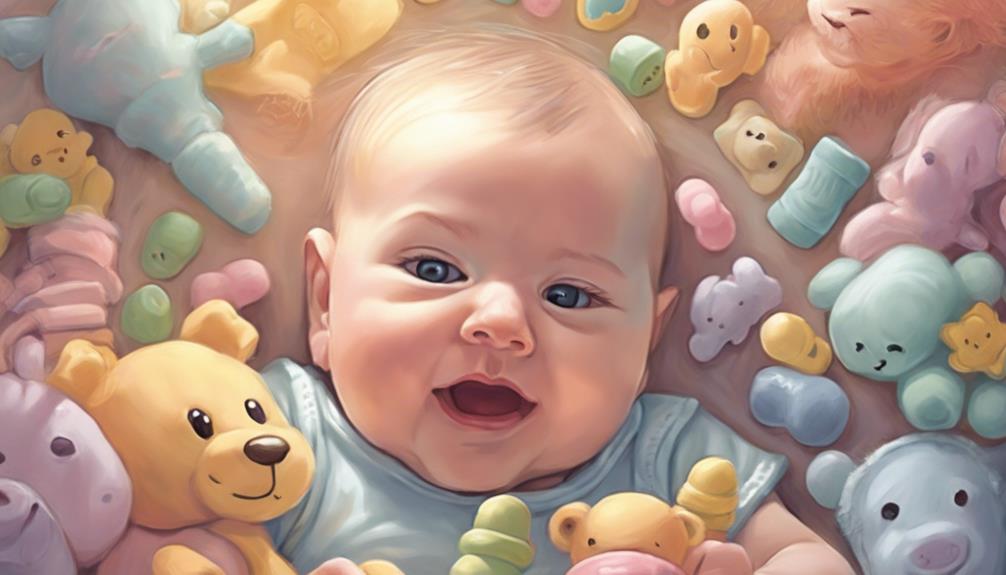
Teething can be a challenging time for both you and your baby, as those tiny teeth start making their way through the gums. Typically, babies start teething between 6 to 12 months of age, with the first tooth erupting generally being the lower central incisors. This process can be uncomfortable, and your baby may experience various teething symptoms, such as sore gums, increased drooling, and irritability. As a parent, it’s important to be prepared and understand the potential discomfort your baby may experience during their teething journey. The baby teething timeline can vary for each child, with some babies experiencing a smooth teething process while others may struggle more. It’s important to provide your baby with soothing teething toys, gentle gum massages, and lots of love and comfort during this time. Remember, this phase is temporary, and soon your little one will have a beautiful set of teeth to show for it.
As your baby's teeth begin to emerge, you might notice their gums become swollen and tender, which can make it difficult for them to eat or sleep. It's important to understand that all 20 primary teeth are already developed beneath the gums at birth, just waiting for the right time to break through. The first tooth erupts usually signals the beginning of a pattern where approximately four teeth appear every six months until all primary teeth are present, typically by age three.
While teething can be tough, it's vital for your baby's dental development, preparing them for future permanent teeth and helping guarantee proper alignment. Being aware of these stages can help you support your little one through this milestone.
Teething Timeline
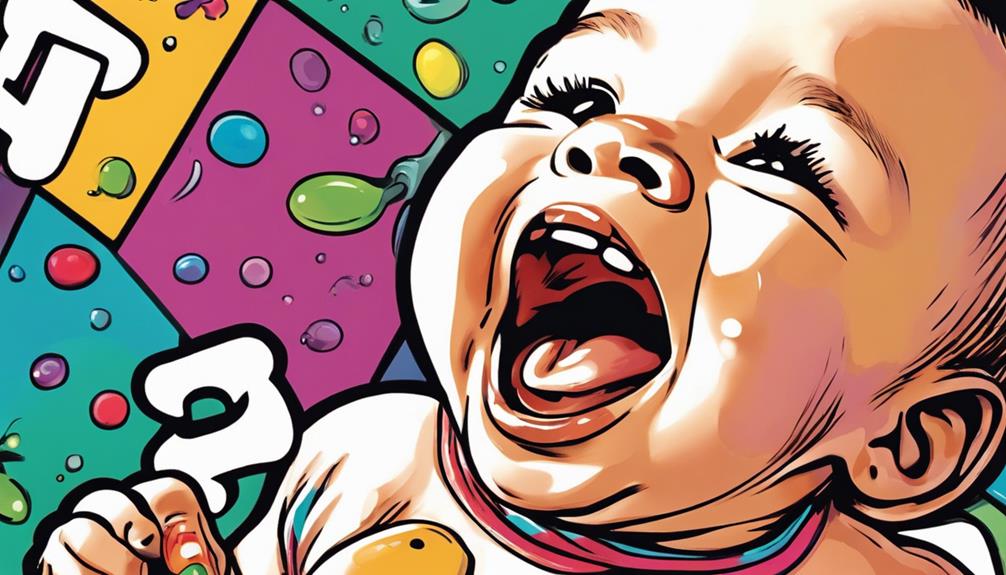
Most babies start showing signs of teething around 6 months, but some might surprise you by beginning as early as 3 months or as late as 12 months. The teething timeline can vary greatly among infants.
Typically, the first teeth to come in are the lower central incisors, which usually emerge between 6 to 10 months. You can expect the upper central incisors to follow, erupting between 8 to 12 months.
As your baby grows, keep an eye on the tooth eruption chart, which indicates that by age 3, most children will have all 20 primary teeth fully erupted. Generally, about four teeth come in every six months. While some babies follow this typical schedule, others may experience teething pain and tooth eruption at different rates.
It's important to remember that each child is unique, and their teething timeline can differ. Some might get their first baby teeth earlier or later than expected, so stay patient and supportive as they navigate this process.
Understanding the teething timeline helps you prepare for the joys and challenges of your baby's dental development.
Signs of Teething
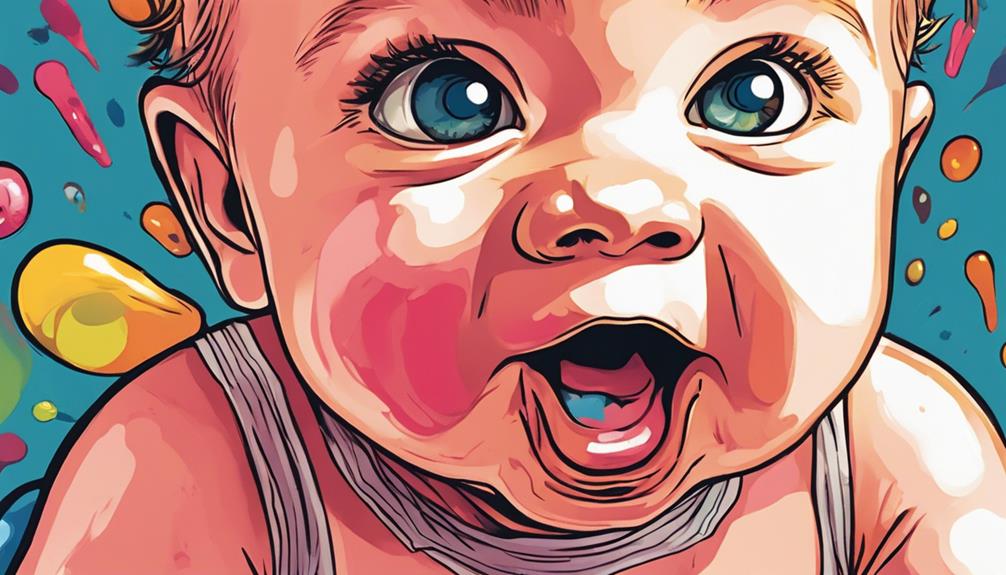
As your baby begins the teething process, you'll notice several signs that indicate discomfort and the emergence of those first baby teeth.
One of the earliest signs of teething is increased drooling, which can leave you reaching for extra bibs. You might also see your baby chewing on objects or even their fingers, seeking relief from the discomfort in their gums.
Swollen gums are another common indicator, and you may notice your little one rubbing their mouth or face as they feel the pressure building. Irritability is typical during this time, as the discomfort can affect your baby's mood and sleeping patterns. You might find that they become fussier than usual or show less interest in feeding, which can be alarming.
Additionally, keep an eye on your baby's temperature. While a slight elevation (less than 100.4°F or 38°C) can occur, remember that a high fever or other serious symptoms warrant a call to your healthcare provider.
Recognizing these signs of teething can help you navigate this challenging stage, ensuring your baby feels supported as those precious teeth start to emerge.
Easing Teething Discomfort
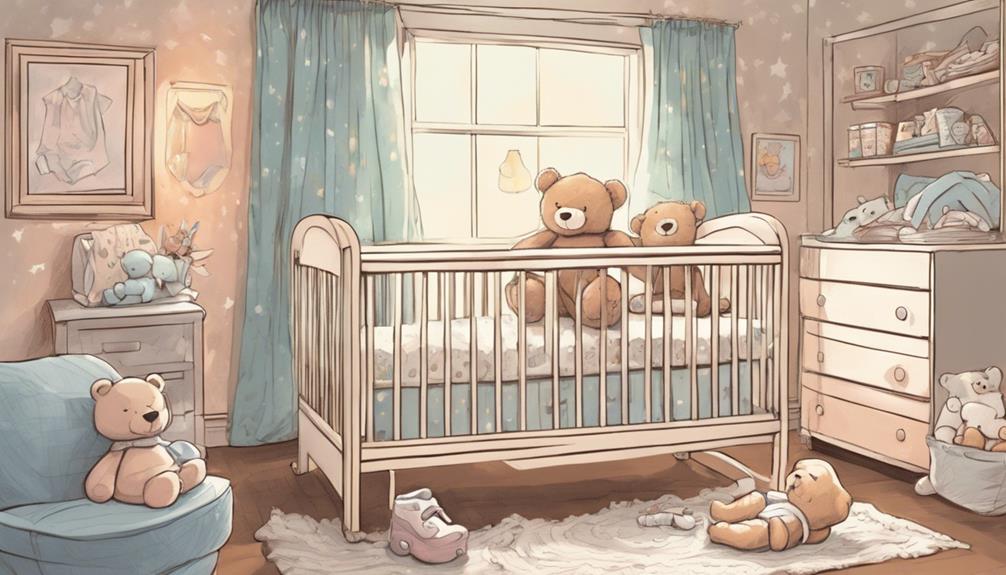
When your baby starts teething, you'll want to find ways to ease their discomfort.
Options like safe chewable items and effective pain relief techniques can make a big difference.
Let's explore some practical methods to help soothe your little one's sore gums.
Safe Chewing Options
Finding safe chewing options can greatly ease your baby's teething discomfort and keep them happy.
One of the best choices is a solid rubber teething ring free from liquid. These rings can help soothe sore gums without posing a choking hazard. You can also chill a clean damp washcloth or a teething ring in the refrigerator to provide temporary relief by numbing the gums.
When selecting teething items, make sure they're large enough to prevent swallowing yet small enough for your little one to grasp easily.
While teething gels might seem appealing, it's best to consult a pediatrician before using them, as not all products are safe for infants.
It's essential to avoid teething necklaces or bracelets, as they present serious risks of strangulation and choking.
Instead, consider natural options like offering chamomile tea in small amounts to help soothe discomfort.
Effective Pain Relief Techniques
Effective pain relief techniques can greatly ease your baby's teething discomfort and help them feel more comfortable during this challenging time. You can try several methods to soothe their aching gums and alleviate teething pain.
- Gently rub your baby's gums with a clean finger to provide relief and comfort.
- Offer chilled teething rings made of solid rubber, which can help reduce pain effectively.
If your little one is experiencing severe discomfort, over-the-counter medications like acetaminophen or ibuprofen may be helpful. However, it's essential to consult your healthcare provider for the correct dosage and guidance.
Keep in mind that while mild fever can accompany teething, you should reach out to your pediatrician if your baby has a true fever or other concerning symptoms.
With these effective techniques, you can help ease your baby's teething discomfort, bringing them relief during this significant milestone in their development. Your support will make a big difference in their comfort and happiness!
Oral Hygiene for Infants
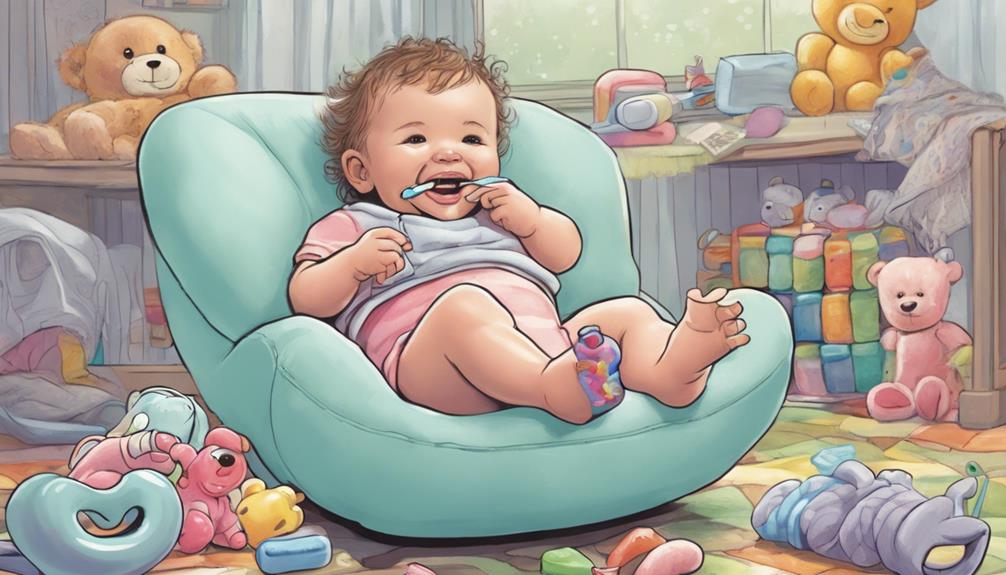
You should start caring for your baby's oral hygiene even before their teeth come in.
Once that first tooth appears, it's essential to use proper brushing techniques and establish a routine.
Regular dental check-ups will help guarantee your little one's smile stays healthy as they grow.
Importance of Early Care
Establishing a routine for oral hygiene is vital, starting even before your baby's first tooth appears. You can promote healthy habits by gently wiping your baby's gums with a soft cloth or gauze.
Once that first tooth makes its debut, it's time to introduce a soft-bristled toothbrush with a smear of fluoride toothpaste. This sets the stage for effective oral hygiene moving forward.
Here's why early care matters:
- Prevents cavities: Starting early helps protect those precious teeth from decay.
- Encourages good habits: Establishing a routine now can instill lifelong dental care practices.
As your baby is teething, don't forget that regular visits to the dentist are important for monitoring dental health. They can guide you on fluoride needs and other dental care practices.
Remember, teaching your child to spit out excess toothpaste when they're ready, usually around age 3, is vital for minimizing fluoride ingestion.
Taking these steps now will help pave the way for a lifetime of beautiful smiles!
Proper Brushing Techniques
A proper brushing technique is essential for keeping your baby's teeth and gums healthy from the very first tooth.
Start by cleaning your baby's gums with a soft cloth or gauze even before that first tooth erupts. This establishes a routine and promotes good oral hygiene.
Once the first tooth appears, grab a small, soft-bristled toothbrush. Use a smear of fluoride toothpaste to brush your baby's teeth and gums twice daily.
As your child grows and learns to spit, you can increase the amount of fluoride toothpaste to a pea-sized amount, usually around ages 2 or 3.
Don't forget to floss between teeth when two teeth touch to maintain proper oral hygiene and prevent decay in those tight spaces.
Regular Dental Check-ups
Regular dental check-ups should start by age 1 or when the first tooth erupts to guarantee your infant's oral health is on track. These visits are vital for monitoring dental development and ensuring proper oral hygiene practices. Establishing a dental home early with a pediatric dentist helps you receive expert guidance on teething and dental care.
Here are a few reasons why regular check-ups are essential:
- They help catch dental issues early, preventing more significant problems down the line.
- Pediatric dentists can apply fluoride varnish to strengthen your child's teeth and prevent decay.
Importance of Fluoride
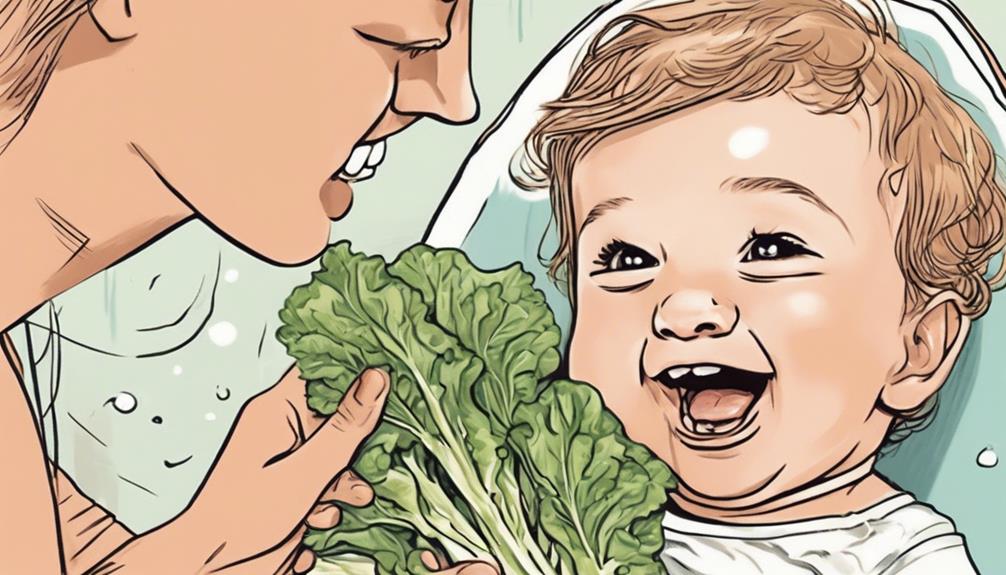
Fluoride plays an important role in strengthening your baby's developing teeth and preventing decay during the teething phase. As your child's primary teeth begin to emerge, making sure they receive adequate fluoride is essential. Most tap water is fluoridated, providing a natural source of this important mineral. However, many bottled waters lack sufficient fluoride, so it's important to check labels.
Pediatricians often recommend introducing fluoride in a sippy or straw cup starting at 6 months to enhance fluoride exposure. Once your baby's first tooth appears, it's beneficial to apply fluoride varnish, which can greatly reduce the risk of cavities in young children. This simple treatment makes a big difference in protecting those developing teeth.
If you're concerned about fluoride levels in your drinking water, consult with your pediatrician about fluoride supplements. They can help determine the right approach to guarantee your baby gets the fluoride they need for strong, healthy teeth.
Common Teething Myths
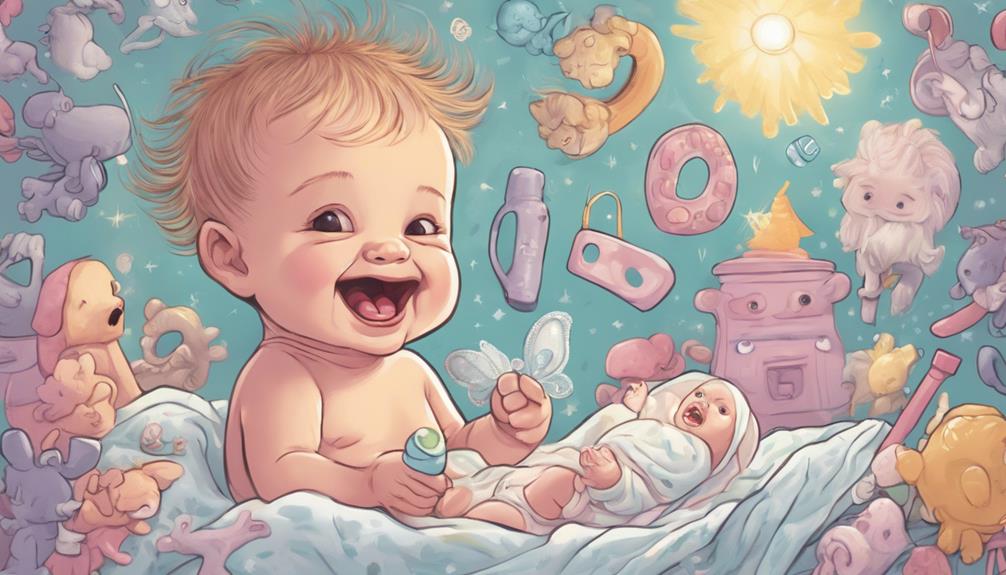
Understanding the role of fluoride in your child's dental health can help clarify some common teething myths that circulate among parents. Many believe teething causes more discomfort than it actually does, leading to unnecessary worry. It's essential to separate fact from fiction.
Here are a few common myths you might encounter:
- Teething causes diarrhea: There's no scientific evidence linking teething to diarrhea; this symptom often signals other health issues.
- Teething leads to high fevers: Most babies experience mild temperature increases, generally below 100.4°F (38°C), not high fevers.
First Dental Visit

Scheduling your baby's first dental visit after their first tooth emerges, usually around age 1, sets the foundation for a lifetime of healthy smiles. Establishing a 'dental home' early on allows you to monitor your child's oral health and receive valuable advice on dental care practices. During this initial appointment, the dentist will assess your child's teeth and gums, checking for any issues that may arise as they grow.
As parents, it's crucial to prepare for the first visit by bringing relevant medical history and discussing any concerns that you might have about your child's dental health. This proactive approach helps the dentist tailor advice specific to your child's needs.
Regular dental check-ups following that first visit will be key to ensuring healthy dental development and preventing future problems.
Teething Remedies to Consider
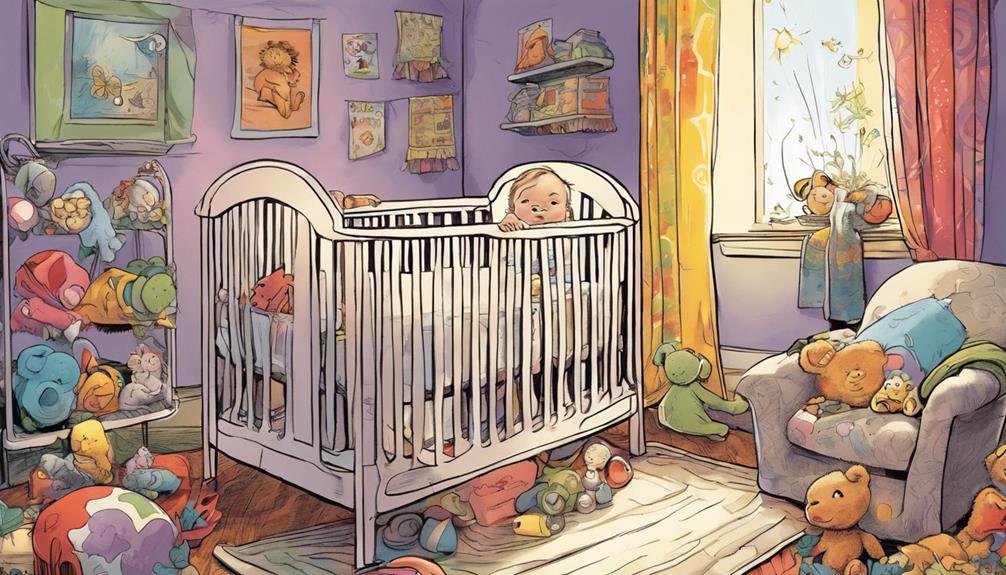
Soothing your baby's teething discomfort can involve a variety of effective remedies that provide relief and comfort. Here are some options to help you navigate this challenging time:
- Cold washcloths or chilled teething rings can soothe sore gums, but make certain they're BPA-free and not filled with liquid.
- Gentle gum massage using a clean finger can offer immediate relief from that pesky teething pain.
While considering these teething remedies, it's crucial to approach over-the-counter pain relief cautiously. Avoid teething gels containing benzocaine for infants under two years, as they pose safety concerns.
If you're exploring natural options like chamomile tea, be sure to consult with a pediatrician before introducing any new remedies.
Your baby's comfort is your priority, so take the time to find what works best for them. By using these safe methods, you can ease their teething experience and keep them smiling!
Frequently Asked Questions
When Should I Expect My Baby's First Teeth?
You can expect your baby's first teeth around 6 months, although some start as early as 3 months or as late as 12 months. Every baby's teething timeline can vary, so be patient.
What Is the Timeline of Baby Teeth Coming In?
You can expect your baby's teeth to emerge in a specific order, starting with the central incisors around 6-12 months. The complete set of 20 primary teeth usually appears by age 3.
Is My 3 Month Old Teething?
Imagine tiny pearls pushing through soft gums. If your 3-month-old's drooling and fussiness seem relentless, they might be teething. However, consult a healthcare provider if you notice a high fever or unusual symptoms.
How Long Does It Take for a Baby's Tooth to Fully Emerge?
A baby's tooth takes about 2 to 3 days to fully emerge after breaking the surface. However, this process can vary, so don't worry if it takes longer; every child's development is unique.
At What Age Can I Expect My Baby’s Teeth to Start Coming In?
Babies typically start teething around 6 months old, but it can vary. Some babies may start as early as 3 months, while others may not get their first tooth until after their first birthday. Keep an eye out for symptoms like drooling and irritability to know when do baby teeth appear.
Conclusion
Teething can be a challenging journey, but you're not alone—every parent navigates this phase.
As you watch your little one grow, you'll discover that those tiny teeth are just as much a rite of passage for you as they're for them.
Remember to keep an eye on their oral hygiene and seek comfort measures that work best for your baby.
Before you know it, you'll both be smiling through this phase, celebrating each new tooth with joy!









